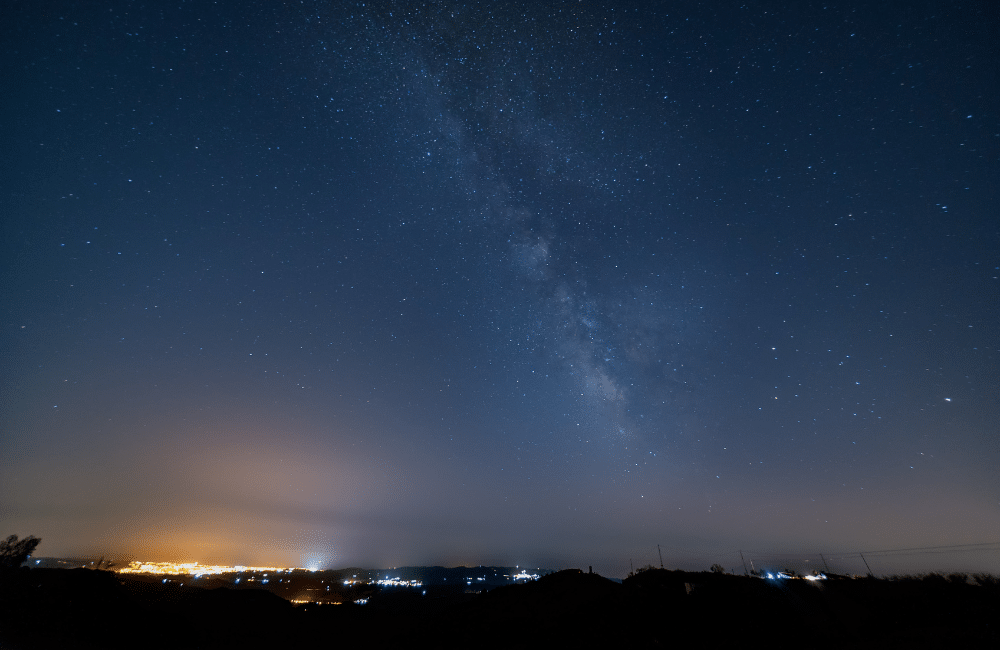CAN WE PREVENT LIGHT POLLUTION?
The term “dark sky” refers to a nighttime environment with minimal artificial lighting, allowing for a natural and unobstructed view of the stars and celestial objects.
Artificial lighting in outdoor spaces is considered necessary in the absence of daylight, for people to feel secure and comfortable when navigating a dark environment.
It may therefore be impossible to eliminate light pollution, but it can certainly be minimised, enabling the darkness of the night sky to prevail.

What is Light Pollution?
Light pollution is the excessive or misdirected artificial light produced by human-made sources such as streetlights, billboards, and buildings.
Humans have radically disrupted the daily cycle of light and dark rhythm that plants and animals (and mankind) depend on to govern life-sustaining behaviours such as reproduction, nourishment, sleep and protection from predators.
The effects of light pollution on flora and fauna are well documented. It can disrupt the migration patterns of birds and insects, alter the behaviour of nocturnal animals, and interfere with the reproductive cycles of many species.
Light pollution can also have a significant impact on plant growth and development. It can cause changes in the timing of flowering and fruiting, alter the composition of plant communities, and reduce the overall productivity of ecosystems as well as have significant negative impacts on human health.
Harmful Effects
Harmful effects of artificial light pollution from man-made sources such as streetlights, billboards and buildings, include:
-
- Disruption of Circadian Rhythms: Many organisms, including plants and animals, have evolved to rely on the natural cycle of day and night to regulate their biological processes. Artificial lights at night can disrupt these circadian rhythms, leading to behavioural and physiological disturbances. For example, light pollution can interfere with the breeding patterns, migration, foraging, and sleep cycles of various species. For humans, it can mess with our melatonin levels and contribute to sleeping disorders. As well as being linked to insomnia, light pollution can also be responsible for depression, cardiovascular disease, and even some cancers.
Ecological Imbalance: Light pollution can create an ecological imbalance by altering the natural patterns of predation and reproduction. Nocturnal animals may be attracted or disoriented by artificial lights, affecting their ability to find food, avoid predators, or locate mates. This disturbance can lead to changes in population dynamics and disrupt the overall functioning of ecosystems. - Disruption of Pollination: Many plants rely on nocturnal pollinators such as moths and bats to transfer pollen between flowers. Artificial lights can attract and disorient these pollinators, affecting their ability to perform their crucial role in pollination. This disruption can have cascading effects on plant reproduction, leading to a decline in plant diversity and ecosystem stability.
- Negative Impact on Wildlife Behaviour: Artificial lights can interfere with the natural behaviour of wildlife. For example, sea turtle hatchlings instinctively move toward the brightest light, which should be the moon reflecting on the ocean. However, when they encounter artificial lights from coastal developments, they can become disoriented, leading them away from the sea and reducing their chances of survival.
- Energy Waste and Environmental Impacts: Excessive and poorly directed outdoor lighting wastes a significant amount of energy, contributing to greenhouse gas emissions and climate change. Moreover, the excessive brightness and glare from artificial lights can degrade the quality of habitats, disrupt natural landscapes, and as above, have negative effects on human health, including sleep disturbances and increased stress levels.
- Disruption of Circadian Rhythms: Many organisms, including plants and animals, have evolved to rely on the natural cycle of day and night to regulate their biological processes. Artificial lights at night can disrupt these circadian rhythms, leading to behavioural and physiological disturbances. For example, light pollution can interfere with the breeding patterns, migration, foraging, and sleep cycles of various species. For humans, it can mess with our melatonin levels and contribute to sleeping disorders. As well as being linked to insomnia, light pollution can also be responsible for depression, cardiovascular disease, and even some cancers.
“Dark Sky” Initiatives
To mitigate the harmful effects of artificial lighting, efforts are being made to promote “dark sky” initiatives, such as designing outdoor lighting that is properly shielded and directed to minimize upward light spill, using energy-efficient lighting technologies, and implementing lighting regulations and guidelines to reduce light pollution.
These measures aim to preserve the natural beauty of the night sky, protect biodiversity, and promote sustainable and responsible lighting practices.
Lighting Control Technologies
Lighting control technologies play a crucial role in preserving dark skies by minimizing light pollution and ensuring that artificial lighting is used efficiently and responsibly.
Here are some key lighting control technologies and their contributions:
-
- Dimming, lux sensing, and schedules: Lighting control systems equipped with dimming capabilities allow for adjusting the intensity of artificial lights. This feature is particularly useful in outdoor environments where light levels can be reduced during off-peak hours or when there is less need for illumination. Schedules can also be employed to automatically turn off or dim lights during specific periods, further reducing unnecessary light emissions. Combined with the use of shields and fixtures that direct light downward, reducing or eliminating upward light spill this alone can prevent wasted light from escaping into the sky and obscuring the view of stars and celestial objects.
- Motion Sensors: Motion sensors can detect the presence or movement of people and animals, triggering lights to turn on only when necessary. This technology helps prevent over-illumination in outdoor spaces by ensuring that lights are activated only when they are needed, reducing energy waste and minimizing light pollution during idle times. Safe “pathways” of light can be provided, to a staff carpark for example, with lights turning on in advance of the person approaching, and then turning off once the person has travelled through.
- Intelligent Lighting Controls: More advanced lighting control systems such as the DALI systems offered by zencontrol are equipped with smart technology and connectivity and offer a range of capabilities for dark sky preservation. These systems can be programmed to adjust lighting levels based on ambient light conditions, astronomical time, or specific events. They can also be integrated with sensors, weather data, and astronomical databases to automatically optimize lighting settings for minimal light pollution. The dashboards offered by the Planview software ensure the visibility of the system and allow the building owner or facility manager to make tweaks and changes to meet their goals in mitigating light pollution.
- Warm-Toned and Low-Intensity Lighting: The International Dark-Sky Association (IDA) recommends that outdoor lighting should not only be shielded to minimise light spillage but should also have colour temperatures below 3000k. Commonly outdoor lighting includes large amounts of blue light which is responsible for brightening the night sky more than any other colour of light. By using a DALI control system, either DALI-2 (wired), or DALI+ (wireless) you can adjust the colour temperature to reduce the detrimental effects of blue light. Warm-toned lighting is less disruptive to nocturnal animals and has a reduced scattering effect in the atmosphere, resulting in less sky glow and better preservation of dark skies.
- Light Zoning and Regulations: Local authorities are under pressure to introduce lighting zoning regulations and guidelines to control the amount, intensity, and direction of artificial lighting in specific areas. Such regulations may include restrictions on outdoor lighting fixtures, required shielding, and limitations on light levels. By enforcing such regulations, communities can ensure that outdoor lighting installations adhere to dark sky principles. Being proactive in this area can demonstrate your company’s commitment to implementing responsible lighting practices.
By employing the lighting technologies outlined above it is possible to significantly reduce light pollution and preserve our dark skies. These efforts contribute to the protection of biodiversity, promote human well-being, and enable future generations to experience the wonder and beauty of a natural and unobstructed night sky.
If you’d like to know more about how lighting control technology can help you achieve your goals, please give us a call.


